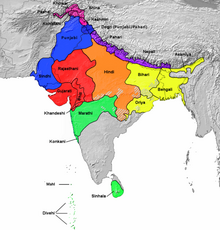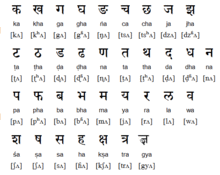lingvo.wikisort.org - Language
The Northern Indo-Aryan languages, also known as Pahāṛi languages, are a group of Indo-Aryan languages spoken in the lower ranges of the Himalayas, from Nepal in the east, through the Indian states of Uttarakhand and Himachal Pradesh, reaching as far west as the Jammu region of Jammu and Kashmir. The name Pahari (not to be confused with the various other languages with that name) is Grierson's term.[1]
This article needs additional citations for verification. (October 2011) |
| Northern Indo-Aryan | |
|---|---|
| Pahari | |
| Geographic distribution | Nepal and north-western India |
| Linguistic classification | Indo-European
|
| Subdivisions |
|
| Glottolog | indo1310 |

Classification
The Pahari languages fall into three groups.
Eastern Pahari
- Nepali is spoken by an estimated 11,100,000 people in Nepal, 265,000 people in Bhutan, and 2,500,000 people in India. It is an official language in Nepal and India.[2]
- Jumli is spoken by an estimated 40,000 people in the Karnali zone of Nepal.[3]
- Doteli spoken by an estimated 1 million people in far west Nepal. It is considered by many to be a dialect of Nepali, according to some scholars (e.g., Rahul Sankrityayan), a dialect of Kumaoni, but the Nepalese Language Commission considers it a separate language.
Central Pahari
- Kumaoni is spoken by an estimated 2,360,000 people in the Kumaon region of Uttarakhand.[4]
- Garhwali is spoken by an estimated 2,900,000 people in Uttarakhand. Most of these are Garhwali people from the Garhwal region of Uttarakhand.
Western Pahari
- Jaunsari
- Hinduri
- Pahari Kinnauri
- Kullu Pahari
- Mahasu Pahari
- Sirmauri
- Mandeali
- Bhadarwahi
- Churahi
- Bhattiyali
- Bilaspuri
- Chambeali
- Gaddi
- Pangwali
- Dogri
- Kangri
Comparison

| Khas-kura (Nepali) | Kumauni | Kashmiri | ||||
|---|---|---|---|---|---|---|
| Masc | Fem | Masc | Fem | Masc | Fem | |
| I am | chhu | chhu | chik | chu | chus | ches |
| You are | chhas | chhes | chai | chi | chukh | chekh |
| He is | chha | chhe | ch | chi | chuh | cheh |
In Eastern and Central Pahari the verb substantive is formed from the root ach, as in both Rajasthani and Kashmiri. In Rajasthani its present tense, being derived from the Sanskrit present rcchami, I go, does not change for gender. But in Pahari and Kashmiri it must be derived from the rare Sanskrit particle *rcchitas, gone, for in these languages it is a participial tense and does change according to the gender of the subject. Thus, in the singular we have: – Here we have a relic of the old Khasa language, which, as has been said, seems to have been related to Kashmiri. Other relics of Khasa, again agreeing with north-western India, are the tendency to shorten long vowels, the practice of epenthesis, or the modification of a vowel by the one which follows in the next syllable, and the frequent occurrence of disaspiration. Thus, Khas siknu, Kumauni sikno, but Hindi sikhna, to learn; Kumauni yeso, plural yasa, of this kind.
Materials regarding Western Pahari are not so complete. The speakers are not brought into contact with Tibeto-Burman languages, and hence we find no trace of these. But the signs of the influence of north-western languages are, as might be expected, still more apparent than farther east. In some dialects epenthesis is in full swing, as in (Churahi) khata, eating, fern, khaiti. Very interesting is the mixed origin of the postpositions defining the various cases. Thus, while that of the genitive is generally the Rajasthani ro, that of the dative continually points to the west. Sometimes it is the Sindhi khë. At other times it is jo, where is here a locative of the base of the Sindhi genitive postposition jo. In all Indo-Aryan languages, the dative postposition is by origin the locative of some genitive one. In vocabulary, Western Pahari often employs, for the more common ideas, words which can most readily be connected with the north-western and Pisaca groups.[citation needed]
About
The Himalayas run along Nepal, India and Pakistan. The word 'Pahar' means a 'mountain' in most local languages such as Nepalese, Hindi (Parbat being a synonym) as well as Urdu (Koh being a synonym). Due to its mass prevalence and usage in the Himalayan Region, the language is also known as Himalayan. Like all other languages of the region, the Pahari languages are also from the Indo-European, and in particular Indo-Iranian branch of languages. As mountains have the tendency of isolating communities from change, dialects in the mountains tend to have their own characteristics with some similarity to others mountain dialects while remaining isolated from one another – there does seem to be a dialect continuum. All of these dialects are commonly referred to as the 'Pahari' languages, and most people from the Himalayan range are known as Paharis.
References
- This article incorporates text from a publication now in the public domain: Chisholm, Hugh, ed. (1911). "Pahari". Encyclopædia Britannica (11th ed.). Cambridge University Press.
- Masica, Colin P. (1991). The Indo-Aryan languages. Cambridge language surveys. Cambridge University Press. p. 439. ISBN 978-0-521-23420-7.
- "Nepali". Ethnologue: Languages of the World. SIL International. Retrieved 23 December 2012.[permanent dead link]
- "Jumli". Ethnologue: Languages of the World. SIL International. Retrieved 23 December 2012.[permanent dead link]
- "Kumaoni". Ethnologue: Languages of the World. SIL International. Retrieved 23 December 2012.[permanent dead link]
External links
На других языках
- [en] Northern Indo-Aryan languages
[it] Lingue pahari
Le lingue pahari (पहाड़ी (Devanagari) da pahar 'montagna'), anche chiamate lingue indoarie settentrionali, sono un gruppo di lingue indoarie, appartenenti alla famiglia linguistica indoeuropea, parlate nella zona himalayana, dal Nepal ad est fino agli stai indiani dell'Uttarakhand, Himachal Pradesh e Jammu e Kashmir ad ovest.[ru] Пахари (языки)
Языки пахари (самоназвание: पहाड़ी) — северная географическая группа индоарийских языков, используемых в нижних Гималаях, от Непала до Уттаракханда, Химачал-Прадеша и Джамму и Кашмира на западе.Другой контент может иметь иную лицензию. Перед использованием материалов сайта WikiSort.org внимательно изучите правила лицензирования конкретных элементов наполнения сайта.
WikiSort.org - проект по пересортировке и дополнению контента Википедии